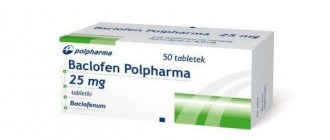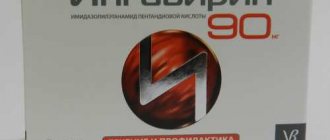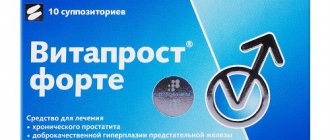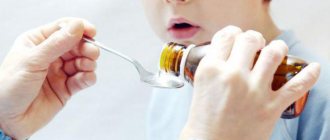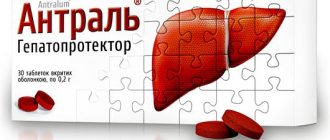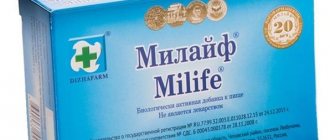Composition and release form
Flamin is available in two dosage forms:
- Tablets for oral administration.
- Granules for the preparation of suspension for oral administration (for children).
Tablets are the dosage form of Flamin for adults, and granules are for children.
The tablets contain 50 mg of immortelle extract and are available in packs of 10 and 30 pieces.
Flamin granules are packaged in sachets containing a single dosage of the drug for children. Each packet of granules contains 5 mg of immortelle extract. Some instructions indicate the dosage of granules as 1.38 g. However, this figure reflects the total weight of the granules in the bag, and not the amount of the active component. Thus, the dosage of the active component in Flamin tablets is 10 times greater than in granules.
The composition of tablets and granules includes dry extract of sandy immortelle as an active component.
Tablets and granules contain the following substances as auxiliary components:
- Magnesium carbonate;
- Potato starch;
- Corn starch;
- Lactose monohydrate;
- Calcium stearate.
Overdose
No recorded clinical cases of overdose have been identified in clinical practice. Theoretically, such a condition is allowed in situations where there is an extreme excess of the permissible dosage of Flamin. Clinically, this may result in increased side effects.
Storage conditions
- Flamin should be stored in a dry, dark, cool place inaccessible to children.
- The optimal temperature should not exceed 20 degrees.
- The shelf life of tablets and granules is the same and is 24 months.
Pharmacological properties
The therapeutic effect of Flamin is due to the properties of biologically active substances included in the immortelle extract. These biologically active substances have a choleretic effect and at the same time improve the overall functional state of the liver, that is, they are hepatoprotectors.
Improving the outflow of bile is achieved through an antispasmodic effect on the bile ducts, sphincters of Oddi and the gallbladder. That is, under the influence of Flamin, the bile ducts and the sphincters that close them relax, their lumen becomes wider, as a result of which bile flows better from the bladder into the intestines.
Relaxation of the sphincters and bile ducts promotes complete emptying of the gallbladder and relieves symptoms of biliary dyskinesia.
In addition to increasing the formation of bile and enhancing its outflow, Flamin reduces the severity of the inflammatory process in the tissues of the liver and biliary tract, which has a positive effect on the condition of these organs. In addition, Flamin enhances the secretion of digestive enzymes by other organs of the gastrointestinal tract, and improves the motor activity of the intestines and stomach.
In principle, Flamin has a comprehensive effect on the area of the liver and biliary tract, improving and enhancing the drainage function of these organs.
By increasing the secretion of bile, metabolic products and toxins present in the body are quickly neutralized and bound by bile acids, and then excreted in the feces. Thus, Flamin promotes detoxification of the body and the removal of toxic substances.
By improving the outflow of bile and reducing its viscosity, Flamin promotes the dissolution of stones present in the gall bladder and prevents their re-formation.
A decrease in the viscosity of bile is ensured by stimulating the formation of bile acids from cholesterol, due to which the concentration of the latter in the bile is significantly reduced.
Pharmacological group
Flamin is a choleretic drug.
Pharmacological effect
Flamin helps the body exhibit choleretic, cholekinetic, choleretic, antispasmodic, anti-inflammatory, antibacterial and wound-healing effects when used.
Pharmacodynamics
- Feminal helps to increase the secretory activity of bile , enhances the difference in the osmotic gradient between the level of blood and bile.
- As the effect on the body increases, osmotic filtration of water and electrolytes into the lumen of the bile capillaries occurs. The speed of bile flow in the bile ducts increases, along with which the canvases leave. These interconnected processes lead to a reduction in the risk of developing cholesterol stones due to the thickening of bile and its gradual concentration near the wall.
- With a decrease in the spasmodic effect on the walls of the biliary tract, the sphincter apparatus also relaxes, which is manifested by a change in the chemical composition of bile and its physical properties.
- Gastric juice is released faster through stimulation of its production centers.
- It has a slight blocking effect on the sphincter and muscles of the intestinal wall , which reduces the evacuation of the food bolus and leads to its more thorough processing.
- Flamin enhances the release of cholesterol , which contributes to the onset of a hypocholesterolemic state in relation to low fractions with gradual replacement by high ones.
It also destroys gram-positive bacteria in the digestive tract, and also helps to enhance the effect of substances such as metronidazole and aminoquinol. This combination has gained wide popularity in the treatment of giardiasis lesions of the body.
Pharmacokinetics
- Application is carried out internally. Flamin has a high degree of absorption from the surface of the gastrointestinal tract.
- After ingestion, it is not found in high concentrations in the blood; only a small amount can be detected in the blood serum.
- As the concentration in the body increases, it accumulates in the liver and kidney cells.
- Flamin is metabolized in the organs of the hepatobiliary system.
- Excretion is carried out mainly through bile, to a small extent it can be urine.
Indications for use
Organic acids in the composition of immortelle extract are detrimental to Giardia, therefore Flamin is recommended to be included in the complex therapy of Giardiasis in combination with Metronidazole and Aminoquinone.
Indications for use Flamin granules and tablets are indicated for use in the following diseases of the gallbladder, liver and biliary tract:
- biliary dyskinesia.
- chronic cholecystitis.
- chronic cholecystohepatitis.
- cholelithiasis.
Based on the results of recent studies, it was found that Flamin is advisable to use in the complex therapy of atopic dermatitis combined with pathology of the gastrointestinal tract.
Indications
The drug is prescribed for any diseases and pathologies of the liver and gall bladder. These include:
- cholecystitis;
- dyskinesia;
- cholecystohepatitis;
- cholelithiasis.
Recent experiences and experiments have proven that this remedy can be taken for the complex treatment of dermatitis and the gastrointestinal tract.
Flamin - instructions for use
Granules (sachets, powder, suspension) Flamin
- Granules from bags are used to prepare a suspension, which is given to children three times a day, half an hour before meals.
- To prepare a suspension of granules from one sachet, add 7.5 ml of water and mix thoroughly.
- To prepare the suspension, water must be boiled and cooled to room temperature. Moreover, you should always use freshly boiled and cooled water.
- You can measure the amount of water required to prepare the suspension with a syringe or spoon. A volume of water of 7.5 ml corresponds to half a dessert spoon.
- The prepared suspension must be used within 10 days. During this period, it should be stored at room temperature in a container with a lid. If after 10 days the suspension is not used in full, then its remains must be thrown away.
- If treatment with Flamin lasts longer than 10 days, then after their expiration it is necessary to throw away the remaining suspension with an expired expiration date and prepare a new one.
Directions for use and dosage
The granules are intended for oral administration. They must be taken 3 times a day. To prepare the suspension, you need to open the sachet, pour the contents into 7 ml of water and mix thoroughly until completely dissolved.
The finished product can be used for 10 days. Children under 3 years of age need to take 1 sachet per day, and children aged 5 years and older are prescribed 5 sachets per day.
Only a doctor can determine the exact dosage based on the diagnosis and age category. Typically therapy lasts for two weeks. If necessary, you can undergo a second course of treatment, but it is worth remembering that there should be a break of two months between them.
The tablets are taken exclusively by adults. You need to take the medicine half an hour before meals. The dosage for each person is prescribed individually. The minimum course of taking the medication is approximately a month. In addition to Flamin, you can simultaneously take other drugs intended to treat the liver.
Contraindications for use
Flamin suspension and tablets are contraindicated for use if a person has the following diseases or conditions:
- individual hypersensitivity or allergic reactions to Flamin components;
- obstruction of the bile ducts;
- obstructive jaundice;
- period of exacerbation of gastric ulcer;
- acute phase of inflammatory diseases of the liver and biliary tract;
- severe liver failure;
- under 5 years of age (for tablets only).
Contraindications and side effects
Side effects when taking Flamin are observed very rarely, since it has a natural composition. an allergic reaction and increased blood pressure may occur
In addition to side effects, there are contraindications in which treatment with this drug is prohibited. These include:
- hypersensitivity to the components of the drug;
- cholelithiasis;
- obstructive jaundice.
The doctor must inform the patient about all contraindications before prescribing the medicine.
The drug Flamin is strictly prohibited from being used simultaneously with Metronidazole and Aminoquinol, as they inhibit the therapeutic properties of each other.
The price of Flamin tablets differs in different pharmacies in Moscow. The cost varies from 100 to 250 rubles per package.
Use during pregnancy and breastfeeding
During pregnancy, you can take Flamin after consulting your doctor. The instructions for use indicate that the characteristics of the drug during pregnancy and breastfeeding have not been studied, and therefore it can only be used if the benefits outweigh all potential risks.
Data from long-term clinical observations are not taken into account. And therefore, despite the fact that clinical observations have shown the safety of Flamin, manufacturers cannot indicate on this basis that it is approved for use during pregnancy. In such situations, manufacturers write in the instructions that the drug is approved for use if the benefits outweigh the risks.
Thus, in fact, this phrase means that Flamin can be taken by pregnant women, of course, with caution.
Side effects
The drug is well tolerated by the patient, however, in some clinical cases, side effects may occur after its use in the form:
- Allergic symptoms (rashes, hyperemia, swelling);
- A sharp increase in blood pressure (if the drug was used in people suffering from hypertension).
- No cases of overdose have been recorded.
Contraindications
Experts do not recommend taking this medication for people who have the following pathologies:
- History of individual intolerance to individual components of the drug;
- If you suffer from stomach ulcers;
- There are symptoms of jaundice, which appeared due to blockage of the bile ducts;
- Not indicated for use in children (under five years of age).
During pregnancy
There is currently no information on whether this drug can be taken while pregnant or while breastfeeding.
Flamin for children
General provisions Flamin is used to treat children from one month. As a rule, the drug is used to eliminate abdominal pain, constipation, flatulence and other symptoms of impaired bile outflow due to biliary dyskinesia, hepatitis and cholecystitis.
Children quite often have a bent gallbladder, which is a constitutional feature that impairs the outflow of bile. As a rule, as the child grows, the bend is corrected and the problem disappears, but until this happens, the baby suffers from abdominal pain, nausea, lack of appetite, flatulence and constipation due to poor outflow of bile from the gallbladder.
Analogs
On the domestic pharmaceutical market, Flamin only has analogue drugs, which include drugs with the most similar therapeutic effect, but containing other active ingredients. So, the following drugs are analogues of Flamin:
- "Allohol" tablets.
- "Artikhol" tablets.
- "Hepabel" tablets;
- "Gepabene" capsules.
- Leptandra compositum drops.
- "Liobil" tablets.
- "Odeston" tablets.
- "Olymethine" capsules.
- "Piflamin" tablets.
- "Polyphytol" tincture.
- "Phebihol" capsules.
- "Holagogum" capsules.
- "Choledius" drops.
- "Cholemax" syrup.
- Choline chloride solution for injection.
- "Holosas" syrup.
- "Cyqualon" tablets.
This list is incomplete; the drug has many analogues.
